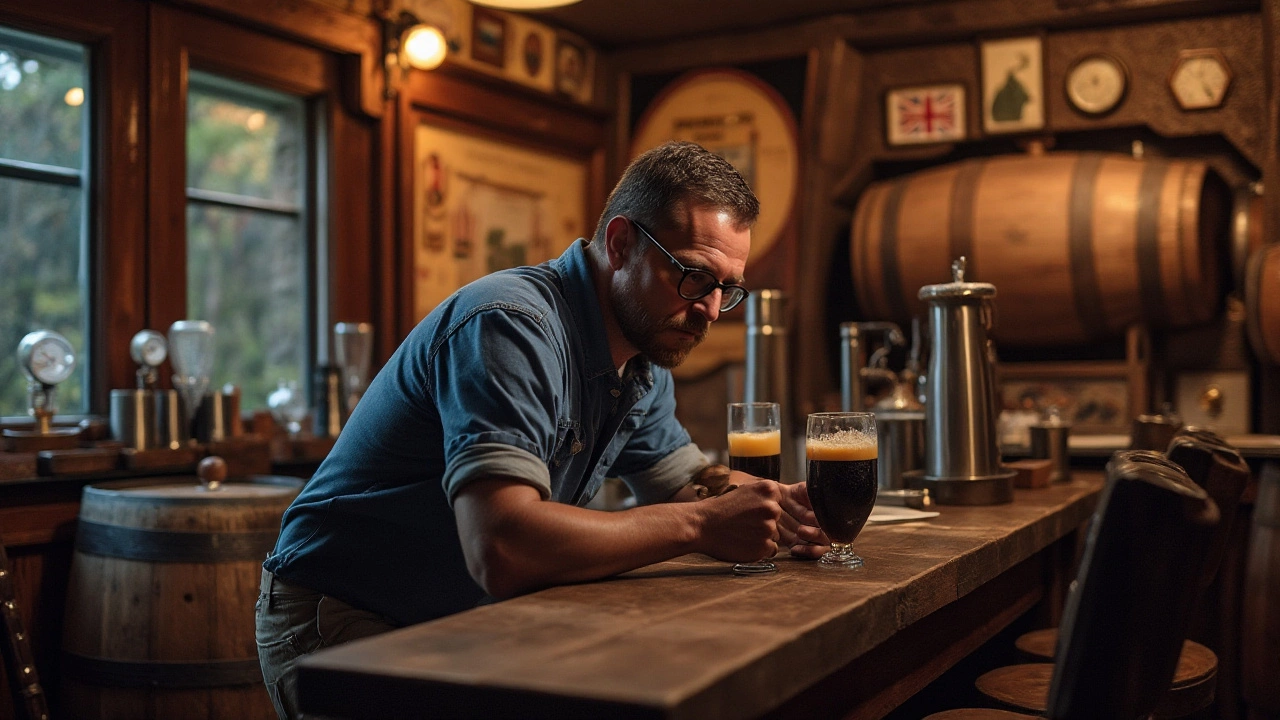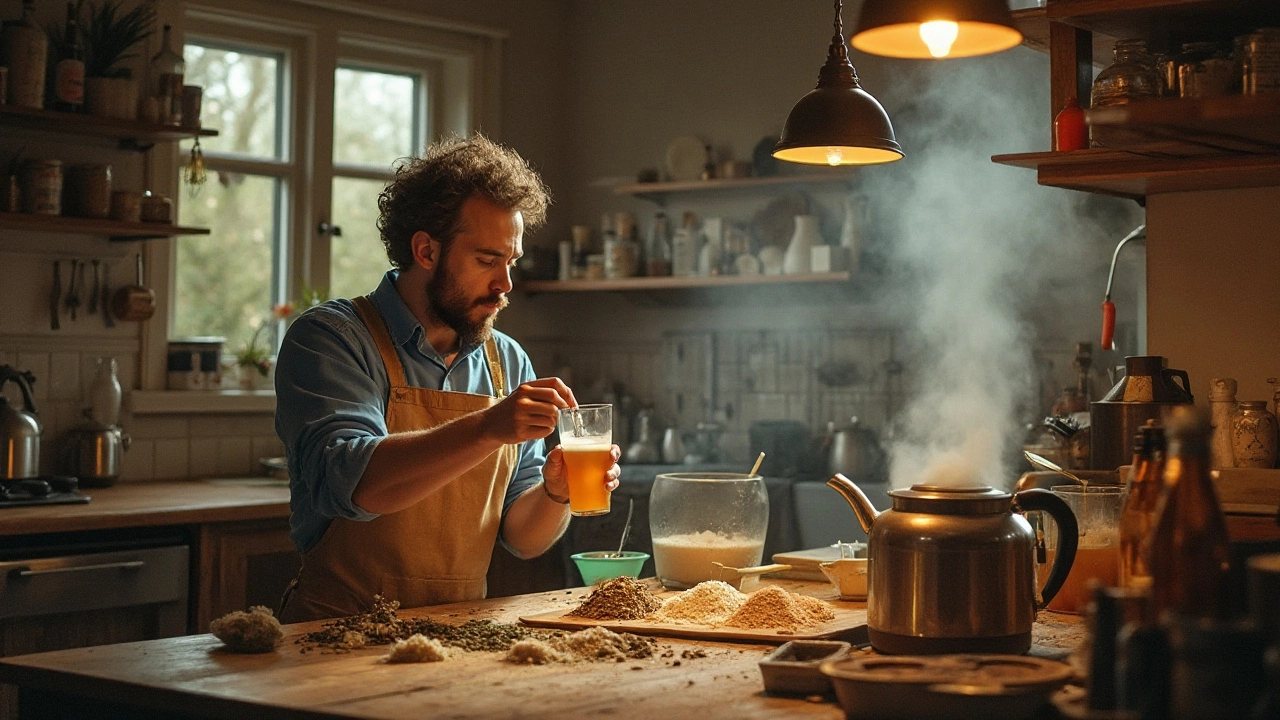Venturing into the realm of homebrewing can be a thrilling endeavor, filled with countless possibilities to explore creativity and flavor. While the satisfaction of a well-crafted homebrew is unmatched, not all beer styles are created equal in terms of brewing difficulty. Some demand a higher level of attention to detail, patience, and manual dexterity.
Why are some beers tougher to homebrew? It might be the intricate processes involved, the particular ingredients required, or simply the hands-on time they demand. The key to mastering a challenging beer style is understanding what makes it difficult and knowing how to navigate the hurdles it presents. This not only enhances the final product but also makes the journey more enjoyable for the brewer.
- Understanding Beer Complexity
- Lagers: Patience is a Virtue
- Sours: Mastering Wild Fermentation
- Barleywines: High Gravity Hazards
- Belgian Trappists: The Yeast Game
- Tips for Tackling Difficult Brews
Understanding Beer Complexity
When we talk about the complexity in beer brewing, it's crucial to recognize that it isn't just about taste. Complexity can involve the brewing process, ingredients, or even the technologies employed. Each beer style carries its own set of particulars that can either simplify or complicate the homebrewing experience. At its core, brewing is a dance of science and art, where the right balance can culminate in a delightful pint. But what makes a beer complex to brew at home often boils down to the technical challenges involved.
Various factors contribute to the complexity of certain beer styles. For instance, the brewing of lagers demands strict temperature control over an extended period, which can be difficult to achieve without specialized equipment. Ales, on the other hand, might seem simpler, but they too have their own quirks. British ales, for example, require the precise balance of malt and hops, demanding careful attention to the brewing process. Moreover, the types of grains used, the boiling time, fermentation methods, and even the water chemistry come into play, elevating the complexity to another level.
Another significant aspect is the yeast, often dubbed the soul of any brew, with its variety playing a critical role in the final outcome. Belgian beers often rely heavily on the yeast's flavor contributions, which means meticulous management of fermentation conditions is necessary. Brewers might find themselves experimenting with different yeasts, each imparting a unique flavor profile to the beer. The nuances of these flavor contributions are what lead brewers to label certain beers as complex.
"Brewing is a blend of science and art, where precise control meets creative expression," says Garrett Oliver, a famed brewmaster and authority in the field.
Technology and skill often intertwine when it comes to crafting complex beers. The proliferation of homebrewing technology such as temperature controllers, fermentation chambers, and advanced yeast profiles allows enthusiastic brewers to tackle what was once a formidable task. Yet, the mastery of these tools requires knowledge and practice, elements that add to what many perceive as the complexity of certain craft beer styles. Some ambitious homebrewers even venture into cask conditioning and barrel aging, processes traditionally associated with commercial breweries but becoming popular in the homebrew community.
Lastly, cultural styles and traditions play a massive role in adding complexity to the brewing process. A classic German wheat beer requires decoction mashing, a technique involving complex temperature controls and multiple mash rests, to bring out the necessary flavors and textures. For many, this melding of tradition and modern technique is part of the allure of brewing such intricate styles. Each bottle becomes not just a drink but a historical artifact, embodying centuries-old traditions.
Lagers: Patience is a Virtue
Lagers, for many, represent the quintessential beer experience, offering a crisp and refreshing taste that is difficult to match. However, homebrewing these delights presents unique challenges that often deter even the most seasoned brewers. The major hurdle with lagers is the need for precise temperature control throughout the brewing process. Unlike ales, which can ferment at room temperature, lagers require a cool fermentation environment, typically between 45 to 55 degrees Fahrenheit. This demands a special kind of equipment—a dedicated beer fridge or temperature-controlled space—which might not be readily available to all homebrewers.
The time commitment involved in producing a well-crafted lager cannot be understated. After the initial fermentation, lagers require an extended maturation period known as lagering, which traces its roots to the German word 'lagern', meaning 'to store.' This step, often lasting several months, allows the beer to condition and develop its clean flavors. Rushing this process can result in off-flavors and a lack of clarity, making patience essential. As the saying goes, anything worth doing is worth waiting for, and this holds particularly true for lager enthusiasts.
Lalon Smith, a craft beer expert, once remarked, "Lagers are a test of a brewer’s resolve, as they demand both precision and patience. They teach you to respect the craft."Such insights capture the sentiment shared by many who have embarked on the lager brewing journey. It’s not just about honing your brewing skills but also about learning to respect the meticulous process that has stood the test of time.
Essential Equipment and Tips
Successfully crafting homemade lagers involves more than just patience; it's also about having the right tools and techniques. First and foremost, investing in a quality fermentation chamber or temperature-controllable system is crucial. This will significantly aid in maintaining those cooler temperatures that are non-negotiable for a solid lager. Many brewers recommend using a water bath setup with an aquarium heater controller for an affordable alternative, as it effectively keeps the temperature steady without breaking the bank.
Besides the equipment, the choice of yeast plays a critical role. Opting for a high-quality lager yeast strain is pivotal, as it influences the flavor and clarity of your brew. Saflager W-34/70 and Wyeast 2124 are popular choices among the homebrewing community. These yeasts perform well under cool conditions and yield that authentic lager character. Another tip is to ensure proper oxygenation of the wort before pitching the yeast. This step helps the yeast to propagate efficiently, leading to a healthier fermentation process.
The Long Wait: Lagering
The lagering phase is where patience truly becomes a virtue. During this stage, which can last anywhere from six weeks to six months, maintaining steady temperatures becomes even more crucial. It's imperative to keep the beer at a consistent temperature, usually around 32-40 degrees Fahrenheit. This helps in ester reduction and flavor development, resulting in a clean, crisp profile that lagers are famous for. Some seasoned brewers advocate for performing a diacetyl rest—a brief period of warming towards the end of fermentation—to prevent buttery off-flavors.
Adding a final layer of challenge, the clarity of lagers is essential to their appeal. To achieve this, many brewers use fining agents such as gelatin or employ cold crashing techniques to force particles to settle before bottling. Regardless of the method employed, the goal is to produce a beer that not only tastes excellent but also looks the part. The clarity and brilliance of a well-brewed lager often speak volumes about the dedication and expertise of the brewer.
In the world of homebrew, lagers often stand as the hallmark of diligence and skill. While they might be one of the harder styles to produce at home, the sense of satisfaction upon pouring that first brilliantly clear, crisp sip makes the entire journey worthwhile. For those intrigued by the challenge, brewing lagers can be a rewarding way to deepen one’s appreciation for the artistry behind beer.

Sours: Mastering Wild Fermentation
Sour beers have captured the imaginations of many a modern-day beer enthusiast, thanks to their complex flavors and distinctive tang. The art of brewing a sour is not just a skill, but an adventurous journey into the realm of wild fermentation. This process relies on harnessing spontaneous fermentation by wild yeasts and bacteria, a practice dating back to the very origins of beer itself. For homebrewers, attempting a sour beer can be both thrilling and daunting. The key challenge lies in achieving the right balance of tartness while ensuring the beer remains palatable. Additionally, there’s the challenge of contaminating your brewing equipment with wild yeasts, which can ruin future batches if not meticulously cleaned. But it is this very unpredictability and complexity that draw brewers to sour beer brewing, offering endless varieties of flavor profiles.
The scientific magic behind sour beers often involves organisms like Lactobacillus and Brettanomyces. These microbes contribute to that characteristic pucker-inducing taste. According to brewing legend and author Michael Tonsmeire, also known as 'The Mad Fermentationist', "Working with wild yeasts requires a careful balance of control and freedom, the ability to guide but also let the yeast take the lead."
Michael Tonsmeire once noted, "Every batch of sour beer writes its own story. Sometimes you get a happy ending, sometimes you have to wait patiently for the right moment.”Patience is the brew master’s greatest virtue, as sours can take months or even years to mature, during which they develop their unique character. Thoughtful blending of different barrels and batches is often necessary to achieve symmetry in flavors, similar to creating a symphony where each note complements the other.
For those eager to test their mettle, starting with a simpler Berliner Weisse or Gose might be more forgiving before venturing into complex Lambics and Gueuzes, which can involve extensive aging and blending. Equipment should be dedicated exclusively to sours to prevent cross-contamination. Maintaining a clean workspace cannot be overemphasized. The joy of sour brewing lies in the journey itself, the suspense and surprise of where the wild fermentation leads you. The reward, a uniquely crafted beer that bears the hallmark of wild yeast's spontaneity, makes every minute of the wait worthwhile.
Barleywines: High Gravity Hazards
Stepping into the world of barleywine brewing is akin to an alchemist's pursuit of turning metal into gold. Known for their strong alcohol content and rich, complex flavors, these high-gravity beers are both a temptation and a challenge for homebrewers. But crafting a barleywine is not for the faint-hearted; it requires precision, patience, and a bit of bravery. One of the primary challenges is managing the high sugar content, which can make the fermentation process quite finicky. Typically, these brews have an original gravity of 1.080 or higher, translating to potential alcohol by volume (ABV) of around 8-12% or more.
The lure of a bold barleywine lies partly in its history, a style that dates back to 18th century England where it was often intertwined with the tales of royalty. The high-gravity nature means substantial sugars need to be broken down by the yeast, which can become overwhelmed, leading to stalled or incomplete fermentation. It's crucial to choose a robust yeast strain capable of handling such high alcohol environments. Oxygen levels during pitching and fermentation need to be just right—too little, and the yeast might not survive the sugar storm; too much, and you risk oxidation, resulting in flavors reminiscent of stale cardboard.
Apart from yeast management, barleywine demands a hearty amount of malt to provide its characteristic sweetness and body. Balancing this malt sweetness with a sufficient hop bitterness is no small feat; a long boil helps caramelize sugars, enhancing complexity. Ingredients are not the only challenge; the aging process plays a crucial role in developing the deep flavors that define barleywine. These beers benefit from a lengthy maturation period, often six months to a year. The wait can test patience, but the payoff can be celestial.
"Barleywines stand as a testament to the brewer's skill, blending strong flavors with finesse," says renowned brewer Garrett Oliver.
Tips for Brewing Success
- Use a yeast starter: Given the high sugar content, a healthy yeast population is vital.
- Monitor fermentation temperature: Keep it steady to avoid off-flavors.
- Be patient with aging: Allow time for flavors to meld and mellow.
While brewing a barleywine can be daunting, the satisfaction of achieving this brew is unrivaled. Embracing its challenges reveals the beauty in the brew: a perfect harmony of strength and elegance, bearing testament to the skill and dedication of its creator.

Belgian Trappists: The Yeast Game
Brewing Belgian Trappist beers at home can be a daunting but rewarding experience. These beers are made in the time-honored traditions of monks, requiring both finesse and patience. What elevates Belgian Trappists from a brewing curiosity to a serious homebrewing challenge is primarily the yeast. This humble organism plays a pivotal role, transforming sugars into the iconic flavors and aromas that make Trappist beers so adored worldwide.
Yeast strains used in these brews are not your everyday varieties. Belgian yeast is known for imparting fruity and spicy notes that define the character of the beer. As homebrewers, understanding the behavior of these strains is crucial. Temperature control is imperative. Belgian yeasts are notorious for their sensitivity; they perform optimally at higher fermentation temperatures. A few degrees too high, and you might amplify unwanted flavors; too low, and you risk a sluggish fermentation process that can dramatically alter the beer's taste profile.
The complexity doesn't stop there. The yeasts used for Belgian Trappists are finicky. They produce esters and phenols in varying proportions, depending on their conditions. These compounds are what give the beer its clove-like, banana, or even bubblegum hints. Successfully capturing these flavors is part art and part science. Many brewers suggest doing a few small batch tests to truly understand how your chosen yeast strain behaves before committing to a full-scale brew. This experimental approach allows adjustment to the variables like pitch rate and fermentation temperature.
Ingredient selection goes hand-in-hand with yeast management. The malt bill, higher in simple sugars, aids the yeast in achieving higher alcohol content without overwhelming sweetness. Belgian Candi sugar is often added to not only boost alcohol potential but also dry out the finish, which is a signature characteristic of stronger Trappist ales. The hops, usually of European varieties like Saaz, Tettnanger, or Styrian Goldings, are used sparingly here. They provide balance rather than bitterness, allowing the yeast's profile to shine through.
Craft beer enthusiasts often debate what makes the perfect Trappist beer. Whether it’s a Dubbel, Tripel, or even a Quadrupel, the delightful burden falls mainly on the yeast. The monks have always known this, having meticulously brewed these ales for centuries. As noted in Beer Advocate's survey on Trappist ales, “The brilliance is in the fermentation, the yeast doesn’t just work, it performs.”
Swirling all these elements together—yeast behavior, ingredient harmony, and fermentation technique—makes Belgian Trappists a pinnacle of homebrew experiences. It's an adventure that requires patience, an open mind to continuous learning, and unwavering dedication. For those willing to play 'The Yeast Game', the reward is a glass of complex, flavorful beer that harkens back to monastic brewing halls. Such mastery of this legendary style can certainly elevate any homebrewer's skill set, with its challenges only amplifying the pleasure when the perfect Trappist brew is finally achieved.
Tips for Tackling Difficult Brews
Embarking on the journey of crafting some of the most challenging homebrews can be daunting, yet incredibly rewarding. The first tip is to embrace patience as a virtue. Time can be a crucial component in brewing complex beers, like lagers, where extended fermentation and aging periods help develop depth and character. Homebrewers should also focus on maintaining precise temperature control throughout the brewing process, as many difficult beer styles, including sours, are sensitive to climatic changes. Investing in a fermentation chamber can ensure stable temperatures, reducing the risk of unwanted flavors.
It's essential to gather accurate information and arm yourself with a wealth of knowledge from credible sources. Knowledge enriches your understanding more than any piece of equipment could. Reading dedicated brewing literature and joining online brewing communities can provide practical insights and shared experiences. As famed brewmaster Charlie Papazian once said,
"Relax, don't worry, and have a homebrew."This encapsulates the idea that even though precision can make or break a challenging brew, the spirit of experimentation should not be overshadowed by the potential for mistakes.
Another crucial aspect is the selection and quality of ingredients. Crafting beers like Belgian Trappists requires attention to specific yeast strains that contribute to unique flavors. Sourcing high-quality malt, hops, and yeast is a fundamental element of brewing success. Regularly checking ingredient freshness and their storage conditions can save a batch from going awry. For high gravity beers like Barleywines, yeast preparation is critical; a yeast starter can greatly enhance fermentation performance. When attempting such big beers, ensure your yeast is at its healthiest by creating a healthy starter culture a few days before your brew day.
Don't underestimate the importance of record keeping. Keeping detailed notes throughout the brew process can pinpoint areas that need refinement and record what worked perfectly. Documenting everything from mash temperatures, pitching rates, gravity readings, and even ambient weather conditions can make future brews more successful. Those records will act like your brewing map, guiding future attempts and bringing you closer to mastering those difficult brews.
Lastly, engage in tasting sessions and seek feedback. Sharing your craft beer with seasoned homebrewers can provide invaluable opinions on how to refine your creations. Encourage constructive criticism and be open to recommendations. Collaborations not only enrich your understanding but also deepen your appreciation for the vast world of homebrewing.


